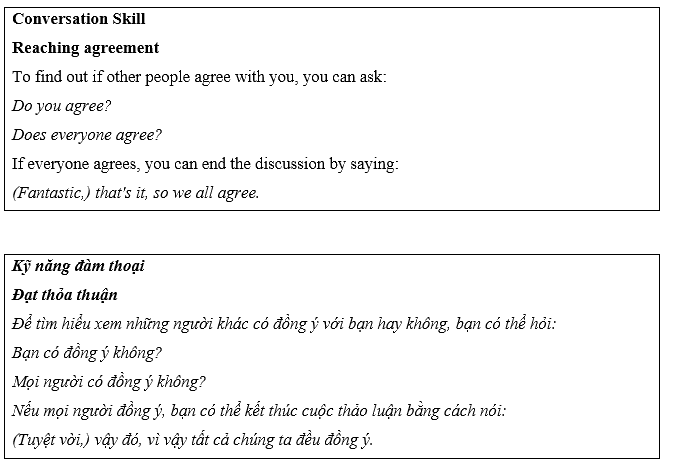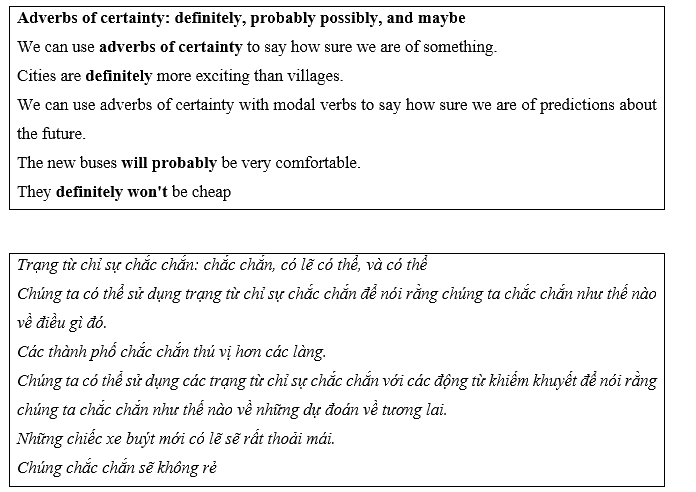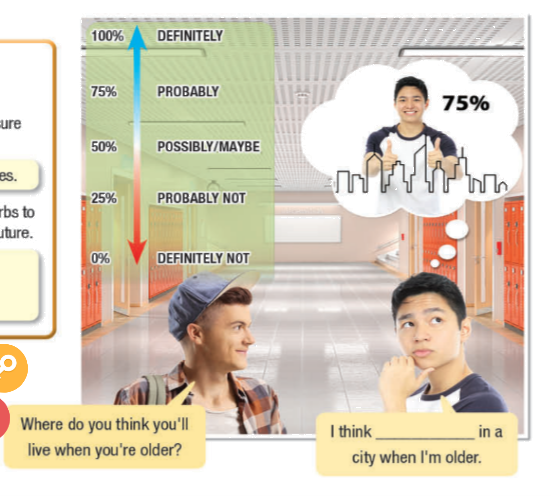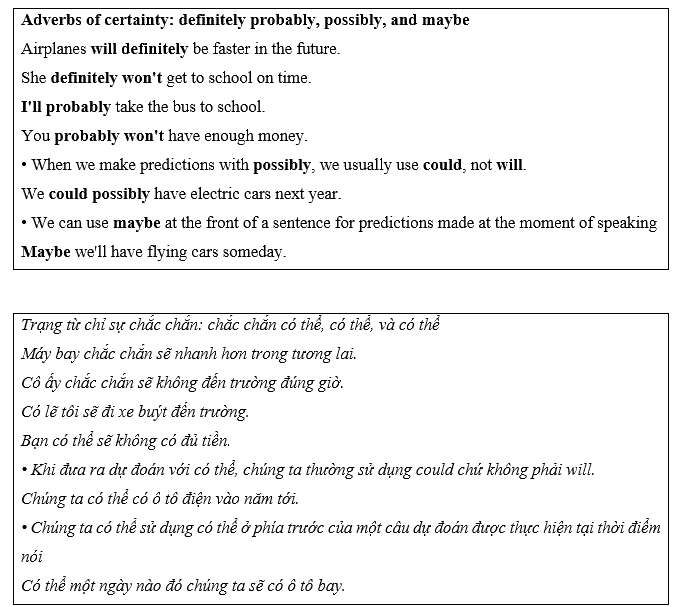Đừng bỏ lỡ những tính năng hấp dẫn của Baitap365.com
In pairs: What's the problem in the picture? Do you use public transportation? Why (not)? a. Find the words from the passage that match the definitions below. Listen and repeat. b. In pairs: Talk about the public transportation where you live, or in a place you know. a. Listen to city planners talking about a new form of public transportation. Do they all think it will have more advantages or disadvantages?b. Now, listen and match.
Let's Talk!
In pairs: What's the problem in the picture? Do you use public transportation? Why (not)?
(Theo cặp: Vấn đề trong bức tranh là gì? Bạn có sử dụng phương tiện giao thông công cộng không? Tại sao (không)?

New Words - a
a. Find the words from the passage that match the definitions below. Listen and repeat.
(Tìm các từ trong đoạn văn phù hợp với các định nghĩa dưới đây. Lắng nghe và lặp lại.)
1. downtown: in or towards the main business area of a city
2. __________: people on their way to work
3. __________: traffic jams
4. __________: done in a way that doesn't waste time, energy, or money
5. __________: the money you pay to travel by bus, plane, or taxi
6. __________: driven by a computer instead of a person
7. __________: a rule about how fast vehicles can travel
Many people live on the outskirts but work in the city center. They travel downtown to their offices. These commuters often have to spend a lot of time in the traffic because of congestion. If their vehicles aren't efficient in fuel use, they'll waste a lot of fuel and money, too. The city should really improve its public transportation system. It should increase the number of buses and reduce the fare. It's still a bit expensive to travel by bus.
In the future, self-driving cars will make driving safer because they won't go over the speed limit. However, the traffic might become even worse. Driving will become safer and more pleasant, but there will be more cars on the street.
Tạm dịch:
Nhiều người sống ở ngoại ô nhưng làm việc ở trung tâm thành phố. Họ đi du lịch trung tâm thành phố đến văn phòng của họ. Những người đi lại này thường phải dành nhiều thời gian tham gia giao thông vì tắc nghẽn. Nếu phương tiện của họ không sử dụng nhiên liệu hiệu quả, họ sẽ lãng phí rất nhiều nhiên liệu và cả tiền bạc nữa. Thành phố nên thực sự cải thiện hệ thống giao thông công cộng của nó. Nên tăng số lượng xe buýt và giảm giá vé. Nó vẫn còn hơi đắt để đi du lịch bằng xe buýt.
Trong tương lai, ô tô tự lái sẽ giúp lái xe an toàn hơn vì chúng không chạy quá tốc độ cho phép. Tuy nhiên, giao thông có thể trở nên tồi tệ hơn. Việc lái xe sẽ trở nên an toàn và dễ chịu hơn, nhưng sẽ có nhiều ô tô hơn trên đường phố.
New Words - b
b. In pairs: Talk about the public transportation where you live, or in a place you know.
(Theo cặp: Nói về phương tiện giao thông công cộng nơi bạn sống hoặc ở một nơi bạn biết.)
The bus fare in Da Nang is cheap. (Giá vé xe buýt ở Đà Nẵng rẻ.)
Listening - a
a. Listen to city planners talking about a new form of public transportation. Do they all think it will have more advantages or disadvantages?
(Lắng nghe các nhà quy hoạch thành phố nói về một hình thức giao thông công cộng mới. Có phải tất cả họ nghĩ rằng nó sẽ có nhiều lợi thế hơn hoặc bất lợi?)
Listening - b
b. Now, listen and match.
(Bây giờ, lắng nghe và nối.)
1. probably
2. probably won't
3. definitely
4. possibly
a. faster than the old buses
b. increase the number of visitors
c. be very expensive
d. use the new buses
Listening - c
c. Read the Conversation Skill box. Then, listen and repeat.
(Đọc hộp Kỹ năng đàm thoại. Sau đó, nghe và lặp lại.)

Listening - d
d. Now, listen again and circle the phrases you hear.
(Bây giờ, hãy nghe lại và khoanh tròn những cụm từ mà bạn nghe được.)
Listening - e
e. In pairs: Would this type of transportation improve your town or city? Why (not)?
(Theo cặp: Loại phương tiện giao thông này có cải thiện thị trấn hoặc thành phố của bạn không? Tại sao (không)?)
Grammar Meaning and Use - a

a. Look at the picture. What do you think the boy is saying?
(Nhìn vào bức tranh. Bạn nghĩ cậu bé đang nói gì?)

Grammar Meaning and Use - b
b. Now, listen and check your ideas.
(Bây giờ, hãy lắng nghe và kiểm tra ý tưởng của bạn.)
Where do you think you'll live when you’re older?
(Bạn nghĩ mình sẽ sống ở đâu khi về già?)
I think I’ll probably live in a city when I’m older.
(Tôi nghĩ có lẽ tôi sẽ sống ở một thành phố khi tôi lớn hơn.)
Grammar Meaning and Use - c
c. Listen and repeat.
(Lắng nghe và lặp lại.)
Where do you think you'll live when you’re older?
(Bạn nghĩ mình sẽ sống ở đâu khi về già?)
I think I’ll probably live in a city when I’m older.
(Tôi nghĩ có lẽ tôi sẽ sống ở một thành phố khi tôi lớn hơn.)
Grammar Form and Practice - a

a. Unscramble the sentences.
(Sắp xếp lại câu.)
1. Commuters/probably/downtown./drive/won't/cars
Commuters probably won't drive cars downtown.
2. more/could/life/expensive./become/possibly/City
3. probably/trains/be/safe./Self-driving/will
4. cars/reduce/downtown/will/congestion./Maybe/flying
5. won't/Speed/be/probably/reduced./limits
6. a/definitely/problem/will/Pollution/bigger/become
Grammar Form and Practice - b
b. Look at the table and write sentences to make predictions about our cities in the future.
(Nhìn vào bảng và viết các câu để đưa ra dự đoán về các thành phố của chúng ta trong tương lai.)

1. We'll definitely have more energy-efficient cars.
2. _____________________________________
3. _____________________________________
4. _____________________________________
5. _____________________________________
6. _____________________________________
Grammar Form and Practice - c
c. In pairs: Ask and answer using the topics in the table and your own predictions and reasons.
(Theo cặp: Hỏi và trả lời bằng cách sử dụng các chủ đề trong bảng cũng như các dự đoán và lý do của riêng bạn.)
Do you think we'll have more energy-efficient cars in the future?
(Bạn có nghĩ rằng chúng ta sẽ có những chiếc xe tiết kiệm năng lượng hơn trong tương lai?)
I think we'll probably have them because we already have some energy-efficient electric cars.
(Tôi nghĩ có lẽ chúng ta sẽ có chúng vì chúng ta đã có một số ô tô điện tiết kiệm năng lượng.)
Pronunciation - a

Pronunciation - b
b. Listen to the words and focus on the underlined letters.
(Nghe các từ và tập trung vào các chữ cái được gạch chân.)
probably possibly
(có lẽ) (có thể)
Pronunciation - c
c. Listen and cross out the one that has the different word stress.
(Nghe và gạch bỏ từ có trọng âm khác.)
occasionally definitely reasonably
(đôi khi) (chắc chắn) (hợp lý)
Pronunciation - d
d. Read the words with the correct stress to a partner.
(Đọc các từ với trọng âm chính xác cho một đối tác.)
Practice - a
a. Take turns asking for and giving opinions about the advantages and disadvantages of the forms of transportation.
(Thay phiên nhau hỏi và đưa ra ý kiến về ưu điểm và nhược điểm của các hình thức vận chuyển.)
Do you think self-driving cars will be safe? (Bạn có nghĩ xe tự lái sẽ an toàn?)
Yes, they'll definitely follow the speed limit because they'll be programed to follow the rules. Does everyone agree?
(Vâng, chúng chắc chắn sẽ tuân theo giới hạn tốc độ vì chúng sẽ được lập trình để tuân theo các quy tắc. Mọi người có đồng ý không?)

Practice - b
b. Practice with your own ideas.
(Thực hành với ý tưởng của riêng bạn.)
Speaking - a
SELF-DRIVING TAXIS: GOOD FOR OUR CITY? (TAXI TỰ LÁI: TỐT CHO THÀNH PHỐ CỦA CHÚNG TA?)
a. You are a city planner discussing self-driving taxis. In groups of three: Discuss each improvement, circle a number from 1 (impossible) to 5 (certain), and add up your scores.
(Bạn là một nhà quy hoạch thành phố thảo luận về taxi tự lái. Trong nhóm ba người: Thảo luận về từng cải tiến, khoanh tròn một số từ 1 (không thể) đến 5 (chắc chắn) và cộng điểm số của bạn.)

Speaking - b
b. Use your total score to decide whether or not to introduce self-driving taxis in your city. Join another group and tell them why you made this decision.
(Sử dụng tổng số điểm của bạn để quyết định có giới thiệu taxi tự lái trong thành phố của bạn hay không. Tham gia một nhóm khác và cho họ biết lý do tại sao bạn đưa ra quyết định này.)
Mẹo tìm đáp án nhanh
Search Google: "từ khóa + baitap365" Ví dụ: "Bài 5 trang 13 SGK Vật lí 12 baitap365